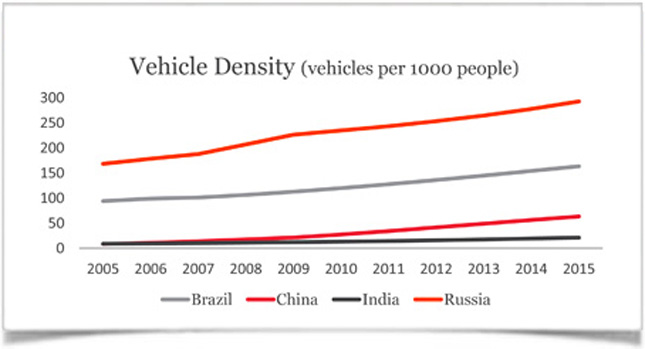According to Polk, an automotive statistics website, one of the key performance indicators of a maturing auto market is the number of cars per 1,000 people or the nation’s “vehicle density”. Ten years ago in the U.S., for instance, it was 453 vehicles per 1,000 people. What with the global financial crisis and high fuel prices resulting in many people selling their cars, this has now dropped to 419 per 1,000 and is expected to continue its decline to 414 per 1,000 by 2015.
 In the increasingly economically developed BRIC countries, that is Brazil, Russia, India and China, it’s not as dense but it is emerging. In Russia, for example, it’s 235 vehicles per 1,000. In India and China, it’s more like 27 vehicles per 1,000. Though consider this: with populations topping 1.6 and 1.3 billion respectively, 27 vehicles per 1,000 would be more like 100 vehicles or plus per 1,000 if those nations had population numbers equaling the United States.
In the increasingly economically developed BRIC countries, that is Brazil, Russia, India and China, it’s not as dense but it is emerging. In Russia, for example, it’s 235 vehicles per 1,000. In India and China, it’s more like 27 vehicles per 1,000. Though consider this: with populations topping 1.6 and 1.3 billion respectively, 27 vehicles per 1,000 would be more like 100 vehicles or plus per 1,000 if those nations had population numbers equaling the United States.
Add to this the fact that India is about a third the size of the U.S. (3,287,263 km2 / 1,269,219 sq.mi vs 3,794,101 sq.mi / 9,826,675 km2 respectively), and we’re talking a lot of cars over a very small area. If India had the same vehicle density of the U.S., there’d be 53 million vehicles chugging around. Talk about a tight fit…
And it’s not like the vehicle density of these countries is stagnating; far from it. In Russia, for example, it’s climbing by about 80% ever five years. What will things be like in India in, say, fifty years? Can India even handle that many cars? Only time will tell.
By Tristan Hankins
Source: Polk



